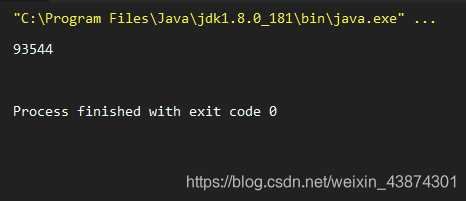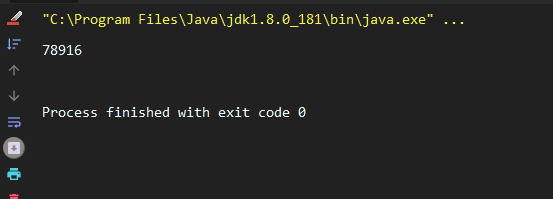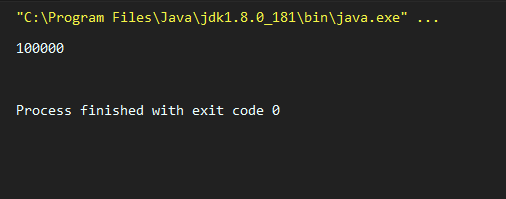版权声明:本文为博主原创文章,遵循 CC 4.0 BY-SA 版权协议,转载请附上原文出处链接和本声明。
本文链接:https://blog.csdn.net/weixin_43874301/article/details/102383087
高并发编程系列(二)
High concurrency programming series
程序在执行过程中,如果出现异常,默认状况锁会被释放
所以,在并发处理过程中,有异常要多加小心,不然会发生不一致的情况,
比如,在一个web app处理过程中,多个servlet线程共同访问同一个资源,这时如果异常处理不适合,
在第一个线程中抛出异常,其他线程进入同步代码区,有可能访问到异常产生的数据.
因此要非常小心的处理同步业务逻辑中的异常
此案例 t1 锁被释放 t2 方可开始
若你不想释放锁请你加入try{}catch{}
public class Tj {
int count = 0;
synchronized void m() {
System.out.println(Thread.currentThread().getName() + "start");
while (true) {
count ++;
System.out.println(Thread.currentThread().getName() + "count: " + count);
try {
TimeUnit.SECONDS.sleep(1);
} catch (InterruptedException e) {
e.printStackTrace();
}
if (count == 5) {
//此处抛出异常,锁将被释放,要想不释放就在此处进行catch,然后循环继续.
int i = 1/0;
}
}
}
public static void main(String[] args) {
Tj t = new Tj();
Runnable r = new Runnable() {
@Override
public void run() {
t.m();
}
};
new Thread(r,"t1").start();
try {
TimeUnit.SECONDS.sleep(3);
} catch (InterruptedException e) {
e.printStackTrace();
}
new Thread(r,"t2").start();
}
}
volatile 关键字,使一个变量在多个线程之间可见
A B 线程都用到一个变量,java默认是A线程中保留一份copy,这样如果B线程修改了该变量,则A线程未必知道.
使用volatile 关键字,会让所有线程都会读到变量值的修改.
在下面代码中,running是存在于堆内存的t对象中,
当线程t1开始运行的时候,会把running的值从内存中读到t1线程的工作区,在运行过程中,直接使用copy,
并不是每次都去使用colatile,将会强制所有线程去堆内存中读取running的值
olatile 并不能保证多个线程共同修改running变量时所带来的一直问题,也就说volatile不能代替synchronized
public class Tk {
//对比一下有无volatitle ,整个程序运行结果的区别
/*volatile*/ boolean running = true;
void m(){
System.out.println("m statr");
while (running) {
}
System.out.println("m end");
}
public static void main(String[] args) {
Tk t = new Tk();
new Thread(t::m,"t1").start();
try {
TimeUnit.SECONDS.sleep(1);
} catch (InterruptedException e) {
e.printStackTrace();
}
t.running = false;
}
}
volatile 并不能保证多个线程共同修改running 变量 时所带来的不一致问题,也就是说volatile 不能代替synchronized
运行下面的程序,分析结果
创建10个线程
volatile 和 synchronized 的区别
volatile 保证可见性并不保证原子性;synchronized 既保证可见性又保证原子性;
synchronized的效率要比volatile低不少 面试必出
public class Tl {
volatile int count = 10;
void m() {
for (int i=0; i<10000;i++) count++;
}
public static void main(String[] args) {
Tl t = new Tl();
List<Thread> threads = new ArrayList<Thread>();
for (int i=0; i<10; i++) {
threads.add(new Thread(t::m, "thread" + i));
}
threads.forEach((o)->o.start());
threads.forEach((o)->{
try {
o.join();
} catch (InterruptedException e) {
e.printStackTrace();
}
});
System.out.println(t.count);
}
}

解决同样的问题的更高效的方法,使用AtomXXX类.原子类
AtmXXX类本身方法都是原子性的,但是不能保证多个方法调用是原子性的.
public class Tm {
/*volatile int count = 0;*/
AtomicInteger count = new AtomicInteger(0);
synchronized void m(){
for (int i=0; i<10000; i++)
//if(count.get()<1000) 注意这里 如果未加锁,之间还会有其他线程插进来
count.incrementAndGet(); //count++
}
public static void main(String[] args) {
Tm t = new Tm();
List<Thread> threads = new ArrayList<Thread>();
for (int i=0; i<10; i++) {
threads.add(new Thread(t::m,"thread" + i));
}
threads.forEach((o)->o.start());
threads.forEach((o)->{
try {
o.join();
} catch (InterruptedException e) {
e.printStackTrace();
}
});
System.out.println(t.count);
}
}
volatile 关键字,使一个变量在多个线程之间可见
A B 线程都用到一个变量,java默认是A线程中保留一份copy,这样如果B线程修改了该变量,则A线程未必知道.
使用volatile 关键字,会让所有线程都会读到变量值的修改.
在下面代码中,running是存在于堆内存的t对象中,
当线程t1开始运行的时候,会把running的值从内存中读到t1线程的工作区,在运行过程中,直接使用copy,
并不是每次都去使用colatile,将会强制所有线程去堆内存中读取running的值
volatile 并不能保证多个线程共同修改running变量时所带来的一直问题,也就说volatile不能代替synchronized
public class Tk {
//对比一下有无volatitle ,整个程序运行结果的区别
/*volatile*/ boolean running = true;
void m(){
System.out.println("m statr");
while (running) {
}
System.out.println("m end");
}
public static void main(String[] args) {
Tk t = new Tk();
new Thread(t::m,"t1").start();
try {
TimeUnit.SECONDS.sleep(1);
} catch (InterruptedException e) {
e.printStackTrace();
}
t.running = false;
}
}不加volatile

添加volatile

volatile 并不能保证多个线程共同修改running 变量 时所带来的不一致问题,也就是说volatile 不能代替synchronized
运行下面的程序,分析结果
创建10个线程
volatile 和 synchronized 的区别
volatile 保证可见性并不保证原子性;synchronized 既保证可见性又保证原子性;
synchronized的效率要比volatile低不少 面试必出
public class Tl {
volatile int count = 10;
void m() {
for (int i=0; i<10000;i++) count++;
}
public static void main(String[] args) {
Tl t = new Tl();
List<Thread> threads = new ArrayList<Thread>();
for (int i=0; i<10; i++) {
threads.add(new Thread(t::m, "thread" + i));
}
threads.forEach((o)->o.start());
threads.forEach((o)->{
try {
o.join();
} catch (InterruptedException e) {
e.printStackTrace();
}
});
System.out.println(t.count);
}
}

解决同样的问题的更高效的方法,使用AtomXXX类.原子类
AtmXXX类本身方法都是原子性的,但是不能保证多个方法调用是原子性的.
public class Tm {
/*volatile int count = 0;*/
AtomicInteger count = new AtomicInteger(0);
synchronized void m(){
for (int i=0; i<10000; i++)
//if(count.get()<1000) 如果未加锁,之间还会有其他线程插进来
count.incrementAndGet(); //count++
}
public static void main(String[] args) {
Tm t = new Tm();
List<Thread> threads = new ArrayList<Thread>();
for (int i=0; i<10; i++) {
threads.add(new Thread(t::m,"thread" + i));
}
threads.forEach((o) -> o.start());
threads.forEach((o) -> {
try {
o.join();
} catch (InterruptedException e) {
e.printStackTrace();
}
});
System.out.println(t.count);
}
}
synchonized优化.
同步代码块中的语句越少越好.
比较m1和m2
public class Tn {
int count = 0;
synchronized void m1() {
//do sth need sync
try {
TimeUnit.SECONDS.sleep(2);
} catch (InterruptedException e) {
e.printStackTrace();
}
//业务逻辑中只有下面这句需要synchronized,这时不应该给整个方法上都上锁
count++;
//do sth need not sync
try {
TimeUnit.SECONDS.sleep(2);
} catch (InterruptedException e) {
e.printStackTrace();
}
}
void m2() {
//do sth need not sync
try{
TimeUnit.SECONDS.sleep(2);
} catch (InterruptedException e) {
e.printStackTrace();
}
//业务逻辑中只有下面这句需要sync 时不应该给整个方法上锁
//采用细粒度的锁,可以使线程争用时间变短,从而提高效率 细粒度锁要比粗粒度锁效率要高
synchronized (this) {
count++;
}
//do sth need not sync
try {
TimeUnit.SECONDS.sleep(2);
} catch (InterruptedException e) {
e.printStackTrace();
}
//do sth not sync
try {
TimeUnit.SECONDS.sleep(2);
} catch (InterruptedException e) {
e.printStackTrace();
}
}
}锁定某个对象o,如果o的属性发生改变,不影响使用.
但是如果o变成另外一个对象,则锁定的对象发生改变.
应该避免将锁定对象的引用变成另外对象
public class To {
Object o = new Object();
void m() {
synchronized (o) {
try {
TimeUnit.SECONDS.sleep(1);
} catch (InterruptedException e) {
e.printStackTrace();
}
System.out.println(Thread.currentThread().getName());
}
}
public static void main(String[] args) {
To t = new To();
//启动线程
new Thread(t::m, "t1").start();
try {
TimeUnit.SECONDS.sleep(3);
} catch (InterruptedException e) {
e.printStackTrace();
}
//创建第二个线程
Thread t2 = new Thread(t::m, "t2");
//锁定对象发生变化,所以t2线程得以进行,如注释掉这句话,线程2将永远得不到执行机会
//锁是锁在堆内存 不是锁在栈内存
t.o = new Object();
t2.start();
}
}不要以字符串常量作为锁定对象
在下面m1 m2 其实锁定的是同一个对象
这种情况下还会发生比较诡异的现象,比如你用到了一个类库,在该类库中的代码锁定了"Hello",
但是你都不到源码,所以你在自己的代码中锁定了"Hello",这时候有可能发生非常诡异的死锁阻塞,
因为你的程序和你用到的类库不经意间使用了同一把锁.
public class Tp {
String s1 = "Hello";
String s2 = "Hello";
void m1() {
synchronized (s1) {
}
}
void m2() {
synchronized (s2) {
}
}
}曾经的面试题
实现一个容器,提供两个方案 add size
写两个线程,线程添加十个元素到容器中,线程2实现监控元素个数,当个数到5个时,线程2给出提示并结束.
但是,t2线程死循环很浪费cpu,如果不用死循环,该怎么做呢?
public class Tq {
//添加volatile 使t2能够得到通知
volatile List lists = new ArrayList();
public void add(Object o) {
lists.add(o);
}
public int size() {
return lists.size();
}
public static void main(String[] args) {
Tq t = new Tq();
new Thread(()-> {
for (int i=0; i<10; i++) {
t.add(new Object());
System.out.println("add" + i);
}
try {
TimeUnit.SECONDS.sleep(1);
} catch (InterruptedException e) {
e.printStackTrace();
}
},"t1").start();
new Thread(()-> {
while (true) {
if (t.size() == 5) {
break;
}
}
System.out.println("t2结束");
},"t2").start();
}
}这里使用wait 和notify做到,wait会释放锁,而notify不会释放锁
需要注意的是这种方法必须保证t2先执行,也就是让t2监听才可以.
阅读下面的程序,并分析输出结果.
可以读到输出结果并不是size=5 t2退出,而是t1结束时t2才可以接收到通知推出
思考为什么
wait 是调用被锁定对象的wait方法 notify
public class Ts {
volatile List lists = new ArrayList();
public void add(Object o) {
lists.add(o);
}
public int size() {
return lists.size();
}
public static void main(String[] args) {
Ts t = new Ts();
final Object lock = new Object();
new Thread(() -> {
synchronized(lock) {
System.out.println("t2启动");
if (t.size() != 5) {
try {
lock.wait();
} catch (InterruptedException e) {
e.printStackTrace();
}
}
System.out.println("t2结束");
}
},"t2").start();
try {
TimeUnit.SECONDS.sleep(1);
} catch (InterruptedException e) {
e.printStackTrace();
}
new Thread(() -> {
System.out.println("t1启动");
synchronized(lock) {
for (int i=0; i<10; i++) {
t.add(new Object());
System.out.println("add" + i);
if (t.size() == 5) {
lock.notify();
}
try {
TimeUnit.SECONDS.sleep(1);
} catch (InterruptedException e) {
e.printStackTrace();
}
}
}
},"t1").start();
}
}
这里是当size=5时,t1线程等,释放锁同时叫醒t2,t2执行,t2执行结束调用notify叫醒t1。
public class Tt {
volatile List lists = new ArrayList();
public void add(Object o) {
lists.add(o);
}
public int size() {
return lists.size();
}
public static void main(String[] args) {
Ts t = new Ts();
final Object lock = new Object();
new Thread(() -> {
synchronized(lock) {
System.out.println("t2启动");
if (t.size() != 5) {
try {
lock.wait();
} catch (InterruptedException e) {
e.printStackTrace();
}
}
System.out.println("t2结束");
//通知t1继续执行·
lock.notify();
}
},"t2").start();
try {
TimeUnit.SECONDS.sleep(1);
} catch (InterruptedException e) {
e.printStackTrace();
}
new Thread(() -> {
System.out.println("t1启动");
synchronized(lock) {
for (int i=0; i<10; i++) {
t.add(new Object());
System.out.println("add" + i);
if (t.size() == 5) {
lock.notify();
try {
lock.wait();
} catch (InterruptedException e) {
e.printStackTrace();
}
}
try {
TimeUnit.SECONDS.sleep(1);
} catch (InterruptedException e) {
e.printStackTrace();
}
}
}
},"t1").start();
}
}